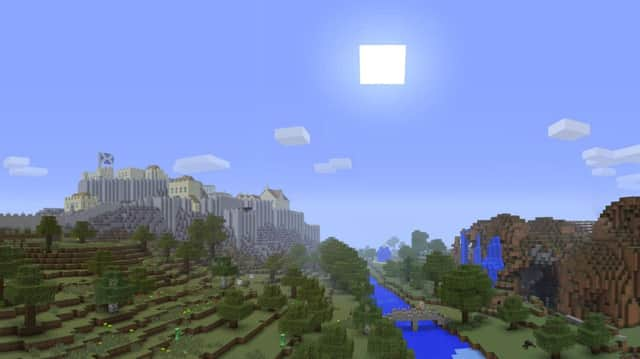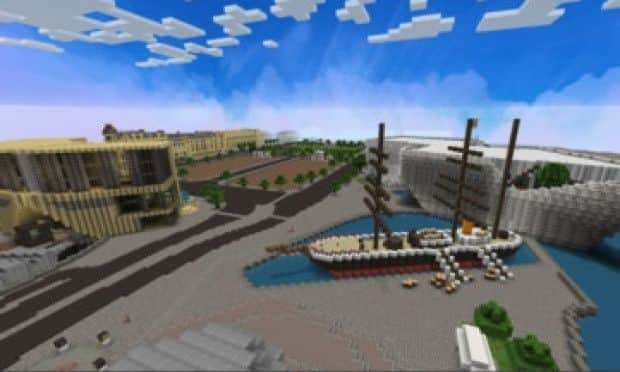A look at the educational possibilities of Minecraft


For everyone else, it can be described in the most basic terms; as a game in which players become the architects of their own online world, designing and building whatever they want to, brick by brick. Despite only being launched in 2009, it is strikingly retro, and its simplicity makes it accessible to the uninitiated it is an unlikely contender for a global gaming phenomenon, but its creator, Swedish programmer Markus Persson, sold it to Microsoft last year for £ 2.5 billion.
The game’s reliance on the creativity of the user is what sets it apart for players, for parents (who overwhelmingly report it as being a positive influence on children) and, increasingly, for educators around the world.
Advertisement
Hide AdAdvertisement
Hide AdDavid Renton, computing curriculum leader at West College Scotland, is one such evangelist for the game’s educational value. While Minecraft is not currently used in courses at the college, Renton teamed up with Scotland’s College Development Network to run a competition for school pupils to design sporting arenas and athletes’ villages around the Glasgow 2014 Commonwealth Games.


He said: “This came about after I met some Norwegian teachers using Minecraft in lessons – they had worked on a project with the children using it to build Viking villages. This was five or six years ago, and the first time I was aware of its use in classrooms. I found it really interesting and we kept in touch.”
The first Minecraft project Renton worked on in 2013 asked pupils from both Scotland and Norway to design their ideal learning environment, and was an experiment in how students interacted while being asked to collaborate.
“Near the beginning a couple teams on either side tried their luck by building inappropriate models inside the virtual world, which led to a chat about what was and wasn’t appropriate in an educational context.
“It was amazing to see how much they built in just four weeks, how motivated they clearly were and how well they collaborated. One student even made tutorial videos to help the others. The Norwegian team made Viking longboats headed to Scotland, and the Scottish team responded by building a wall with ‘Keep out’ written on it and cannons. By the end of the project it said ‘Welcome to Scotland’ – although they did keep the cannons.”
The following year, the year of the Glasgow Games, the project expanded to take in eight countries (including some which needed the concept of the Commonwealth Games explained – Norway, the USA) and pupils ranged in age from 10 to 20, for those in school and colleges.
Renton asserts that one of the advantages of Minecraft is that it can be used with very young learners and to develop a huge range of skills, including planning, design, collaboration, creativity and logic, not to mention programming – an ability he cites as increasingly vital for those coming of age in a digitally-focused world.
“From its early days, the Minecraft community has been able to do its own mod-ing [gamer-speak for making modifications to the program
Advertisement
Hide AdAdvertisement
Hide AdThe game therefore teaches programming skills and makes it exciting learning them. And in terms of career opportunities, programming is a big thing. I’ve spoken to companies based in Scotland that can never fill their programming jobs; they just cannot get enough programmers and jobs are often filled from countries like Ukraine.”
Hour of Code
In December the Hour of Code is taking place in more than 180 countries - a global event, with tutorials and work across all age groups demonstrating how Minecraft is now being used to promote and stimulate education and learning. Based in Scotland, Stephen Reid and Immersive Minds has created an online education resource that includes Minecraft. Using games-based learning, they reach out to people across the world using online tutorials to enable the power of games to enhance and support curriculum learning.
But to look at Minecraft as solely a way of engendering programming skills in young learners would be a somewhat narrow approach, and one that belied the true potential of its impact in education on a curriculum-wide level. By taking a step back and thinking about the themes that can be applied to Minecraft projects, coupled with the natural affinity of so many children to this environment, teachers all over the world have been able to teach a huge range of concepts, principles and topics to their classes. And we need look no further than Scotland for an innovative example.
Steven Reid of Immersive Minds is an education consultant specialising in gaming as a way of learning, and during a recent presentation at Microsoft’s Future Decoded event, he shared some of the ways in which he has helped teachers to facilitate learning through Minecraft. One such project saw Reid prepare a world of finite resources, in which the students had to complete a variety of construction tasks. However, unless they replanted some of their felled trees, they would inevitably run out of wood, and would fail the task. The lesson? Ecology and sustainability. Other lesson plans included having the students recreate historical events and literary works in Minecraft, or building molecules such as double stranded DNA.
So while fundamentally an exercise in programming, with a little imagination on the part of the teacher and the students, you really can use Minecraft to teach just about anything.
Renton also believes that beyond teaching skills vital for a growing industry, the use of Minecraft in education also helps redress an imbalance within that industry – the gender gap.
“One of the problems we still have in computing is that it’s male-dominated. On our computing course there are 300 students and only 30 are female, while of 100 students on my video game development course, three are female. But we saw during these competitions we ran that Minecraft is changing that among younger pupils – at least half of the school children already played it, both boys and girls equally.
“Women actually now make up the majority of mobile gamers, but this is not reflected in the games industry. Girls I’ve spoken to have said the portrayal of women in video games is one thing that still puts them off entering the industry. Some say they wanted to take computing at school but didn’t because they didn’t see it as a job for them.
Advertisement
Hide AdAdvertisement
Hide Ad“Minecraft is really valuable in terms of getting girls involved and interested in programming. It’s gender-neutral – it’s not a boys’ club, because it’s what you make of it.”
Dundee
One Scottish city in particular has notably embraced education in digital creativity. Dundee has become internationally renowned for courses taught in animation and video game design and technology at, respectively, the University of Dundee’s Duncan of Jordanstone College of Art and Design and Abertay University.
A global hub for digital design, the birthplace of Lemmings and Grand Theft Auto (the latest instalment of which is the fastest selling entertainment product of all time, earning $1 billion within three days) will also be the setting for this year’s Royal Society of Edinburgh Christmas lecture, to be given by Stampy – also known as Minecraft vlogger/guru Joseph Garrett, the Justin Bieber of the gaming world (although his videos get more monthly hits), with 6.6 million YouTube subscribers.
For Derek Robertson, a lecturer in education at the University of Dundee, the hope is that traditional education will reciprocate by incorporating digital resources in teaching, and he believes the use of Minecraft in education offers opportunities not just for teaching particular subjects and skills, but for studying the fundamentals of how we learn.
In the academic year 2014-15, Robertson ran a research project in conjunction with Dundee City Council in 15 schools in the city, which challenged primary 6 and 7 pupils to use Minecraft to redesign Dundee’s waterfront area – currently under the spotlight shone by the V&A project and a £1bn regeneration.
“To me what is really interesting is that Minecraft is an example of a digital space that young learners have situated themselves in, without the intervention of schools. It’s a very complex and challenging environment and they are in control of it. We can actually learn from them in this situation. Young people are uploading Minecraft tutorial videos to YouTube; being both the learners and the teachers. There is an intrinsic motivation and desire to be in these educational spaces, without our intervention. This represents a cultural shift, and that’s what’s really interesting for me.”
Robertson, who plays Minecraft with his young daughters, and was recently invited to take part in a Minecraft Educators Summit in Los Angeles, first became interested in the educational potential of computer games as a classroom teacher in the Nineties. “Some of the boys brought in a Super Nintendo on the last day of term and, watching them play a game of building with 2D blocks, they were exhibiting all the skills we were looking to teach them, which we were not managing in all cases.
“When learners have mastery of the domain, research shows heightened levels of motivation. These are cultural domains they are situating themselves in, by choice, and research shows that when we exploit this we get a tremendous response. Our research into educational uses of Minecraft brings up a lot of things around the dynamic between teachers and learners, and a lot of questions about the dynamics of this relationship.”
Advertisement
Hide AdAdvertisement
Hide AdThis was borne out by the response from teachers involved in the waterfront design research project, who reported a transformation in attitude and attainment in pupils, saying that the use of Minecraft was particularly valuable to those pupils who don’t respond as well to traditional teaching techniques. They reported a positive effect on behavioural issues, and correspondingly on the self-esteem of pupils who had previously struggled in the classroom. The results in terms of how pupils worked together were similarly striking.
Robertson said: “Co-operative learning skills are in fashion in schools right now. What we found in our research project is that [when using Minecraft] children are organising themselves – it’s a mutual, egalitarian team effort. When we surveyed how the children organised and distributed the work amongst themselves, we found that only 4 per cent needed a teacher to intervene. Situating learners in a cultural domain they’re comfortable with brings out the best in them.”
Robertson’s next idea for research into Minecraft’s educational uses is a project based on pupils’ “rebuilding” historical Scottish sites as they think they might have looked. Ultimately, he hopes to see Minecraft used in Scottish schools in any number of ways, calling it: “Something Scottish education needs to be thinking about. Northern Ireland recently bought Minecraft EDU – the Minecraft schools’ edition – for all its secondary schools. It doesn’t even need the “EDU” added to the name; it’s already educational.”
• This article was produced in partnership with Microsoft